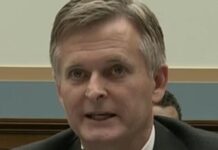
After three years of tumult and revised scientific analyses, the Trump administration Tuesday formally relaxed Obama-era fuel economy rules that aimed to reduce greenhouse gas emissions and stall the effects of climate change.
Under the new rules, automakers will have to meet less stringent targets for cars and light-duty trucks through 2026. According to the administration’s own analysis, the change will increase emissions of carbon dioxide by 867 million to 923 million metric tons through 2030, hindering efforts to limit global warming to 1.5 degrees Celsius and avoid the worst of climate change. The transportation sector is the nation’s largest source of greenhouse gas emissions.
The Obama-era rule would have required automakers to increase the average fuel economy of their fleet by nearly 5 percent a year, to 54.5 miles per gallon by 2025, nearly double what it was in 2012. The new regulation requires 1.5 percent annual increases, reaching a fleet average 40 miles per gallon by 2026.
On a call with reporters Tuesday, government officials argued that the new rule balances environmental concerns with economic ones, because it is projected to reduce the price of new vehicles by between $977 to $1,083. (The average US vehicle costs $38,000.) Transportation Secretary Elaine Chao called the Obama-era rules “unrealistic regulatory burdens.” The administration has argued that lower prices will allow more Americans to buy newer, safer versions of popular vehicles, including less fuel-efficient SUVs and trucks.
But the government’s own scientific advisers have challenged its analysis. In February, a science advisory board appointed by the US Environmental Protection Agency concluded there were “severe simplifications and flaws” in an earlier draft of the rule, which would have frozen mileage standards at 2020 levels. Scientists whose work was cited in that draft said their findings had been misrepresented, and also called out flaws in the analysis. After the draft received a hailstorm of public criticism—including 750,000 public comments, many of them negative—the administration went back to the drawing board. Critics say the rule adopted Tuesday will still require Americans to spend more on gas, negating any savings at the dealership.
The new rule is the administration’s second effort to relax environmental rules for cars. Last fall, the EPA stripped the state of California of its special authority to set its own standards for tailpipe emissions, a power dating back to the first clean air rules, in the 1970s. That exemption had allowed California, and 14 other states that joined it, to set stricter emissions standards. Twenty-three states have sued the EPA to preserve California’s right to regulate autos on its own.
The new rule will likely spark another lawsuit. California Attorney General Xavier Becerra told reporters Tuesday the state would consider suing the federal government over the fuel efficiency standards. Natural Resources Defense Council President Gina McCarthy, a former EPA administrator, was less subtle. “We’ll be seeing the Trump administration in court,” she wrote in a statement.
If that happens, the administration will face an uphill battle, says Julia Stein, an attorney and the project director at the the Emmett Institute on Climate Change and the Environment at UCLA Law School. The administration faces a higher legal bar because it’s seeking to roll back an existing regulation, a process that’s governed by strict federal rules. And the flawed draft analyses that laid the foundation for the rollback will no doubt come up in court.
The regulatory rollbacks put automakers in a tricky spot. Last summer, four—Ford, Honda, Volkswagen, and BMW—agreed to follow California’s tougher emissions standards. Under that deal, automakers would produce fleets averaging 51 miles per gallon by 2026, one year later than the Obama-era target. The agreement was an effort to stave off the worst scenario for automakers: having to manufacture two sets of cars for different states. On Tuesday, California officials said Volvo was poised to join the four other companies in the compromise, leaving General Motors, Fiat Chrysler, and Toyota on the side of the government.
With its members divided, the biggest auto industry group Tuesday tried not to take sides. “Automakers need a policy environment that drives not only fuel economy improvements, but that also supports the infrastructure, market, and other conditions necessary for the transformation of light-duty vehicles to a lower- and net-zero carbon future,” said John Bozzella, president and CEO of the Alliance for Automotive Innovation. “We are carefully reviewing the full breadth of this final rule to determine the extent to which it supports these priorities.”
The president has been frustrated by the lack of support from automakers for his rollback plans. On Tuesday, Trump complained on Twitter that automakers did not accept his earlier offer to rescind regulations even more dramatically. “Foolish executives!” he tweeted.
Nationwide concern over the spread of Covid-19 has not dampened the administration’s fervor for cutting environmental regulations. It’s pressing forward with efforts to allow coal plants to release more mercury and toxic ash into the air, and to loosen the requirements for companies seeking to build large infrastructure projects—like highways and pipelines—that could affect the environment. In some ways, the administration is under the gun. One federal law, the Congressional Review Act, gives Congress the power to overturn any regulation finalized in the last 60 days of the congressional calendar. If Democrats win control of Congress and the White House in November, any regulation not nailed down by late May could be reversed with a simple majority, instead of a years-long rulemaking process.









